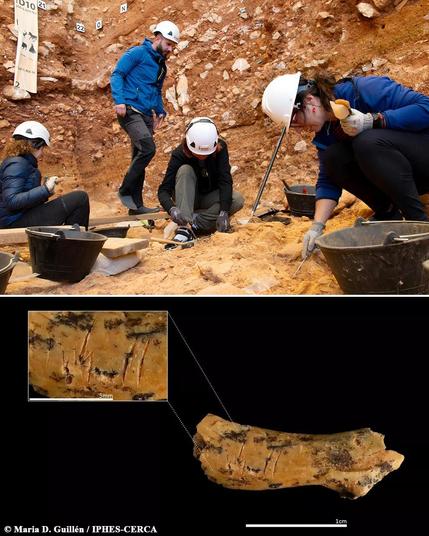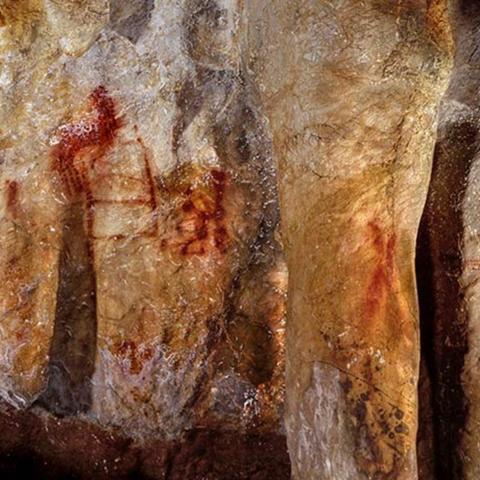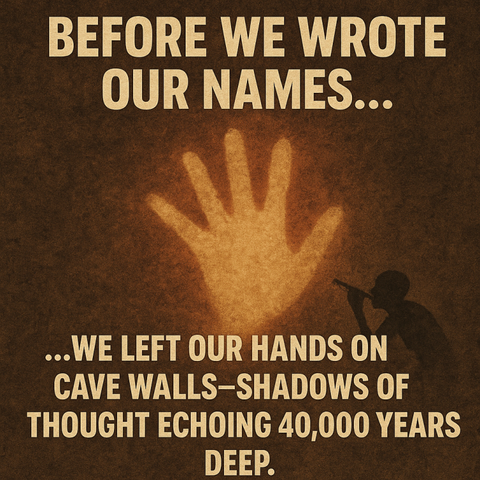The Echo of a Hand Across Millennia: Decoding the Cave Hand Stencil
Introduction
Imagine the dim glow of flickering firelight, casting dancing shadows on rough cave walls, thousands of years before history began. In the silence, broken only by the gentle breath of a painter, a hand presses against the cool, damp stone. A cloud of red ochre pigment fills the air, settling around the hand to leave a lasting imprint. This humble act resonates through time, speaking volumes across countless generations. The hand stencil, a ghostly echo from our distant ancestors, represents humanity’s earliest attempt at permanence—a poignant declaration: I was here. These timeless marks, etched in caves worldwide, whisper of identity, presence, and belonging, inviting us to imagine the lives, dreams, and stories of those who came before.
Creation and Technique
Creating a hand stencil required careful preparation and delicate execution. Artists mixed powdered ochre or manganese with binding agents such as animal fats or saliva, creating a vivid, lasting pigment. Hollow bone tubes, reeds, or even direct blowing through pursed lips were used to spray this mixture onto cave surfaces, leaving negative hand impressions as the pigment settled around the outstretched fingers and palm (Pike et al., 2012). Positive stencils, conversely, involved coating the hand directly with pigment and pressing firmly onto the rock. The skill and care in producing these artworks suggest the artists were respected community members entrusted with preserving their group’s identity.
Geographical Distribution
The universality of hand stencils spans continents and millennia, connecting disparate groups through a shared expression of humanity: – El Castillo Cave, Spain (approximately 40,800 years old), where stencils offer a vivid glimpse into the artistic traditions of Europe’s earliest inhabitants (Pike et al., 2012). – Leang Timpuseng Cave, Indonesia (around 39,900 years old), highlighting the global reach of this simple yet profound gesture (Aubert et al., 2014). – Cueva de las Manos, Argentina (circa 11,000 to 7,500 BCE), bearing witness to the enduring legacy of hunter-gatherer communities (UNESCO, 1999). – Maltravieso Cave, Spain (66,700 years old, Neanderthal), pushing back the boundaries of our understanding of human creativity and symbolism (Hoffmann et al., 2018).
Anthropological and Cognitive Significance
Hand stencils offer anthropologists a rare glimpse into the minds of early humans, revealing their cognitive sophistication and symbolic capabilities. Jean Clottes (2016) interprets these markings as powerful symbolic dialogues, possibly connecting humans with spiritual worlds or ancestors. Such interpretations illuminate the complex, multi-layered meanings embedded in these ancient symbols, suggesting hand stencils were not mere decorations but deeply intentional expressions of identity, spirituality, and community bonds.
Makers of the Marks
The diversity among hand stencil creators adds depth to our understanding of prehistoric societies. Morphometric studies indicate that women and children were significant contributors, evident from the varying sizes and proportions of handprints in sites like Pech Merle and Rouffignac Cave, France (Van Gelder & Sharpe, 2009). Indeed, roughly one-quarter of known stencils were crafted by young hands, suggesting these caves were inclusive spaces of communal gathering, learning, and cultural transmission (Guthrie, 2005). The presence of young artists underscores the social nature of cave art, where cultural heritage and knowledge passed seamlessly across generations.
Symbolic Meanings
Hand stencils often carry deeper symbolic meanings, frequently depicted with intentional missing fingers, possibly signifying complex communication methods, ritualistic practices, or symbolic gestures of sacrifice and belonging (Snow, 2006). At Gargas Cave, the repeated appearance of such stencils implies deliberate artistic choice rather than accidental loss or injury, hinting at a sophisticated form of proto-communication or ritual symbolism (Groenen, 2016). These enigmatic symbols provoke endless curiosity and interpretation, inviting us to explore ancient societies’ profound yet mysterious belief systems.
Neanderthal Artists
The revelation of Neanderthal-created hand stencils at Maltravieso Cave drastically reshapes our understanding of these ancient relatives. Dating to approximately 66,700 years ago, these artworks predate modern human presence in Europe, demonstrating Neanderthals’ capability for abstract thought, artistic expression, and symbolic communication (Hoffmann et al., 2018). This discovery challenges long-standing stereotypes, positioning Neanderthals as sophisticated beings with complex social structures, rituals, and creative traditions—indelibly marking their legacy within humanity’s shared heritage.
Personal Reflection and Modern Resonance
Handprints transcend historical and cultural divides, resonating deeply within modern consciousness through their universal symbolism of identity and continuity. Today, a child’s handprint evokes a profound emotional connection, bridging the vast temporal gap between ourselves and our ancestors. As parents guide their children’s hands onto clay or paper, they unknowingly echo the same intimate gesture practiced thousands of years earlier in shadowy caves. This continuity reflects humanity’s enduring quest for meaning, connection, and permanence, uniting generations through shared gestures of presence and belonging.
Conclusion
Hand stencils serve as timeless symbols of humanity’s deepest needs: recognition, belonging, storytelling, and community. These simple marks assert presence, convey complex meanings beyond language, and profoundly connect us to our earliest ancestors. They invite modern observers to reflect on our shared humanity and the eternal impulse to leave a mark upon the world, asserting with silent dignity: We are here.
Works Cited
Aubert, M., Lebe, R., Oktaviana, A. A., Tang, M., Burhan, B., Jusdi, A., … & Brumm, A. (2019). Earliest hunting scene in prehistoric art. Nature, 576(7787), 442–445. https://doi.org/10.1038/s41586-019-1806-y
Aubert, M., Pike, A. W. G., & Stringer, C. (2014). Pleistocene cave art from Sulawesi, Indonesia. Nature, 514(7521), 223–227. https://doi.org/10.1038/nature13422
Bednarik, R. G. (2008). Children as Pleistocene artists. Rock Art Research, 25(2), 173–182. https://www.academia.edu/1443733/Children_as_Pleistocene_artists
Clottes, J. (2016). What is Paleolithic Art? (D. Coltman, Trans.). University of Chicago Press.
D’Errico, F., & Vanhaeren, M. (2017). Hand to mouth: The origins of symbolic behaviour seen through the study of dental wear and artefacts. Philosophical Transactions of the Royal Society B: Biological Sciences, 372(1725), 20160377. https://doi.org/10.1098/rstb.2016.0377
Groenen, M. (2016). Handprints and fingerprints in rock art. Arts, 5(1), 1–12. https://doi.org/10.3390/arts5010007
Guthrie, R. D. (2005). The Nature of Paleolithic Art. University of Chicago Press.
Hoffmann, D. L., Standish, C. D., García-Diez, M., Pettitt, P. B., Milton, J. A., Zilhão, J., … & Pike, A. W. G. (2018). U-Th dating of carbonate crusts reveals Neanderthal origin of Iberian cave art. Science, 359(6378), 912–915. https://doi.org/10.1126/science.aap7778
Pike, A. W. G., Hoffmann, D. L., García-Diez, M., Pettitt, P. B., Alcolea, J., De Balbín, R., … & Zilhão, J. (2012). U-series dating of Paleolithic art in 11 caves in Spain. Science, 336(6087), 1409–1413. https://doi.org/10.1126/science.1219957
Snow, D. R. (2006). Sexual dimorphism in European Upper Paleolithic cave art. American Antiquity, 71(4), 663–678. https://doi.org/10.1017/s0002731600039840
UNESCO World Heritage Centre. (1999). Cueva de las Manos, Río Pinturas. https://whc.unesco.org/en/list/936
Van Gelder, L., & Sharpe, K. (2009). Women and girls as Upper Paleolithic cave “artists”: Deciphering the sexes of the hands at Rouffignac Cave, France. Oxford Journal of Archaeology, 28(4), 323–333. https://doi.org/10.1111/j.1468-0092.2009.00332.x
Wreschner, E. E. (1983). Red ochre and human evolution: A case for discussion. Current Anthropology, 24(5), 605–625. https://doi.org/10.1086/203067
Zilhão, J., Angelucci, D. E., Badal-García, E., d’Errico, F., Daniel, F., Dayet, L., … & Higham, T. (2010). Symbolic use of marine shells and mineral pigments by Iberian Neandertals. Proceedings of the National Academy of Sciences, 107(3), 1023–1028. https://doi.org/10.1073/pnas.0914088107
Zilhão, J., & d’Errico, F. (1999). The chronology and taphonomy of the earliest Aurignacian and its implications for the understanding of Neandertal extinction. Journal of World Prehistory, 13(1), 1–68. https://doi.org/10.1023/A:1022348410845
#AncientHumans #Anthropology #ArchaeologicalFinds #Archaeology #ArtHistory #CaveArt #DeepHistory #EarlyHumans #HandStencils #HumanOrigins #HumanStory #NeanderthalArt #Paleoanthropology #PaleolithicArt #Prehistory #RockArt #ScienceCommunication #SymbolicArt #WorldOfPaleoanthropology #archaeology #evolution #history #Science




